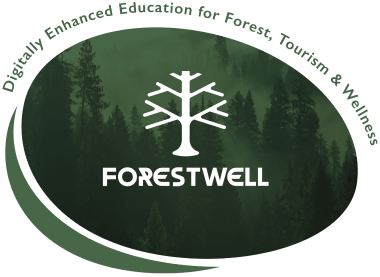
Topic Progress..
Overview of Topic 2.3 Regenerative ForestWell Approaches Needs Regenerative Thinking & Action. Regenerative ForestWell approaches require a fundamental shift towards regenerative thinking and action. This paradigm goes beyond sustainability, focusing on actively dismantaling the ‘normal way of doing business’ and restoring and enhancing natural, humans and business systems. By adopting regenerative thinking, ForestWell initiatives will have a holistic mindset that recognises the interconnectedness of all systems and emphasises the importance of continuous improvement, innovation, and community engagement. The ultimate goal is to create a flourishing future where tourism and human activities contribute to the well-being of ecosystems and communities.
To fully embrace regenerative approaches it is essential it is backed up and underpinned by regenerative thinking. By integrating regenerative thinking ForestWell intiatives can dynamically, adaptively and practically move towards a future where human activities contribute positively to the environment, economy, and society, ensuring a healthier and more resilient planet for future generations
Regenerative thinking is a holistic approach that goes beyond sustainability, aiming not just to maintain but to actively restore and enhance natural systems. This forward-thinking mindset is crucial for creating a future where ForestWell tourism and human activities have a positive impact on the planet. Here are some key reasons why regenerative thinking is essential for:
Environmental Benefits: It is used to restore natural ecosystems by integrating regenerative practices and approaches to help mitigate climate change, enhance biodiversity, and improve ecosystem services such as water purification and air quality.
Social and Economic Benefits: Regenerative thinking promotes social equity and economic resilience. It creates opportunities for local communities, improves quality of life, and ensures that economic development is inclusive and sustainable.
Enhanced Well-being: Regenerative practices and approaches contribute to the overall well-being of individuals and communities. Healthier ecosystems provide cleaner air and water, more recreational opportunities, and greater food security, leading to improved physical and mental health.
Regenerative Approaches to Design and Regenerative Thinking in the context of ForestWell is further explored in the next topic.
The heart of regenerative thinking is a fundamental shift in thought and action that leads to the recognition that everything is interconnected and that humans, other living beings, and ecosystems must rely on one another for health.
“Being Regenerative” means to reinvent, regrow and bring in new vigorous life and vitality. In leading businesses, it adds value because it works and it is essential to future flourishing.
“Being Regenerative” means recognising more value comes back to us when we act with the knowledge of living systems in mind. This comes in the form of financial returns, agility and resilience, innovation, morale improvement and enthusiastic engagement. Leaders who make this shift consistently unleash the power of Regeneration to enjoy a new surge of energy in their companies. Through continuous regeneration, they realize higher multiples in valuations and achieve major leaps in business success. (Source Being Regenerative: Your Key to Flourishing in the Future)
ForestWell Regenerative Thinking. In ForestWell, regenerative thinking is a holistic approach that goes beyond sustainability by continuously improving and actively regenerating the resources and ecosystems upon which human activities depend. The aim is to align human activities with the natural systems that support life on Earth, thereby creating a more sustainable and regenerative future. This approach prioritises sustainability, innovation, long-term thinking, and adaptive learning. The ultimate goal is to enhance the well-being of individuals, communities, and nature. Changing mindsets and attitudes are seen as crucial in this endeavour.
A ‘regenerative’ mindset is one that sees the world as built around reciprocal and co-evolutionary relationships, where humans, other living beings and ecosystems rely on one another for health, and shape (and are shaped by) their connections with one another. It recognises that addressing the interconnected social and environmental challenges we face is dependent on rebalancing
Recommended Reading What Does ‘Regenerative’ Thinking Mean?
The regenerative lens is an approach that goes beyond sustainability by focusing on restoring and revitalising ecosystems, communities, and economies. Originating from regenerative design principles, which advocate for systems that renew and evolve over time, this perspective emphasises harmony with natural processes and proactive efforts to heal the planet.
For ForestWell, applying a regenerative lens means creating tourism experiences that not only minimise harm but actively contribute to the health of forest ecosystems and local communities. This can involve practices like reforestation, habitat restoration, and integrating local cultural knowledge into tourism activities. By adopting regenerative practices, ForestWell businesses can form a deeper connection between guests and nature, promoting a culture of stewardship and resilience. This approach ensures that the benefits of tourism extend beyond economic gains, contributing to the long-term vitality and sustainability of natural and human systems.
Regenerative thinking is an approach that goes beyond traditional sustainability practices by focusing on the restoration, regeneration and revitalisation of ecosystems, communities, and economies. It aims to create systems and processes that not only sustain current resources but actively improve and regenerate them for future generations. Here are the core principles of regenerative thinking:
Step 1 Breakdown and “Screw up the status quo”, as a business in and effort to do the right thing. Honor and hold onto the company’s good parts from the past, but recognise what is no longer working, and work to transform and regenerate. Aim to do less harm in your business practices then try to create a positive future that is nourishing of the greater social and living system, and do it as part of enabling your business to flourish.
ForestWell businesses must challenge traditional tourism and wellbeing practices that are often unsustainable and disconnected from nature. This involves questioning and dismantling established norms and routines that contribute to environmental degradation and superficial travel experiences.
Example: Instead of building a standard accommodation structure. Consult the community and architects and planners on how you can make it blend in with the environment and what sustainable materials are that you can use. For example to protect the beauty and nature of the area offer eco-friendly lodging options such as treehouses, glamping tents, and cabins that are not permanent fixtures, blend into the environment and are made from sustainable materials. These are eco-friendly accommodation that disrupt the status quo by providing eco-conscious alternatives.These not only provide unique and memorable stays but also minimize the environmental footprint.
Step 2 Change the Mindset. This is where as a company you truly understand what it takes to be regenerative and that it involves making transformational choices in a positive direction for all. Transformational choices and decisions come from regenerative thinking where you tackle vicious circles that are not sustainable and turn them into virtuous circles of value creation that enables communities and eco-systems to self regenerate. Often tough decisions are made from moral choices and making the right choice for all even when it is hard for business.
ForestWell businesses shift the mindset of their businesses, communities and tourists towards a more sustainable and mindful approach. Education and awareness are key to engaging a deeper appreciation for nature and a commitment to environmental stewardship.
Example: ForestWell businesses can conduct workshops and seminars that teach sustainable living practices, conservation efforts, and the benefits of reconnecting with nature to the public, their staff, stakeholders, partners, communities and visitors. These can include hands-on activities like tree planting, composting, and using natural resources responsibly. This empowers both visitors and staff with knowledge and motivation to protect the environment.
Step 3 Regenerate. Where you find the solution and make the regnenerative choice to add substantial positive value back into your systems for the benefit of the greater systems of which they are part of. So you are now moving past the ‘business as usual’ game to maximise growth and profit and now focusing on the benefit of the greater social and environmental systems. It is important to not the aim is to still do better for all, including your business but to try and stop making things worse. The key is to spiral upward to greater value createion and positive impact on the world. This Regenerative mindset will eventually replace the past “business as usual” paradigm. Forward thinking leaders see this inevitability and are working to make the change now in preparation for the future.
ForestWell businesses ultimate goal is to achieve breakthrough impacts that create significant value and enrich lives. This involves offering experiences that not only provide personal benefits to visitors but also contribute positively to the environment and local communities.
Consider the following to get you started,these can be applied to most ForestWell businesses
Example Education and Advocacy Strategy for Guests: ForestWell can offer immersive wellness retreats that combine physical activities like yoga, meditation, and forest bathing with educational components about sustainability and conservation. ForestWell businesses can organise interactive conservation programs where guests actively participate in activities such as tree planting, wildlife monitoring, and habitat restoration. These hands-on experiences educate visitors about the importance of conservation and involve them directly in the regenerative process.Guests leave not only rejuvenated but also inspired to adopt and advocate for eco-friendly practices in their own lives.
Example Community Collaboration Strategy: Get communities to engage in projects that restore natural habitats, forests and support local communities. Collaborate to offer cultural exchange programs where visitors can learn about indigenous practices and traditional ways of living in harmony with nature. This could include storytelling sessions, traditional crafts, and local cuisine.This ensures the environmental and economic benefits are long-lasting and impactful.
Example Habitat Restoration Projects and Programs with Partners: Partner with environmental organisations to offer educational programs, volunteer opportunities, and joint initiatives that promote conservation and restoration efforts. These partnerships can enhance the credibility and impact of ForestWell’s sustainability initiatives. Collaboration can amplify the reach and effectiveness of regenerative practices, providing guests with more opportunities to engage and contribute meaningfully.
Source: Beam Inc Consult
Source Images: Beam Inc Consult
For more information, you can explore the works of thought leaders in regenerative thinking, such as John Fullerton’s “Regenerative Capitalism” and Carol Sanford’s “The Regenerative Business”. These resources provide deeper insights into the principles and applications of regenerative thinking. https://medium.com/age-of-awareness/regenerative-leadership-96a52a4f1e10
